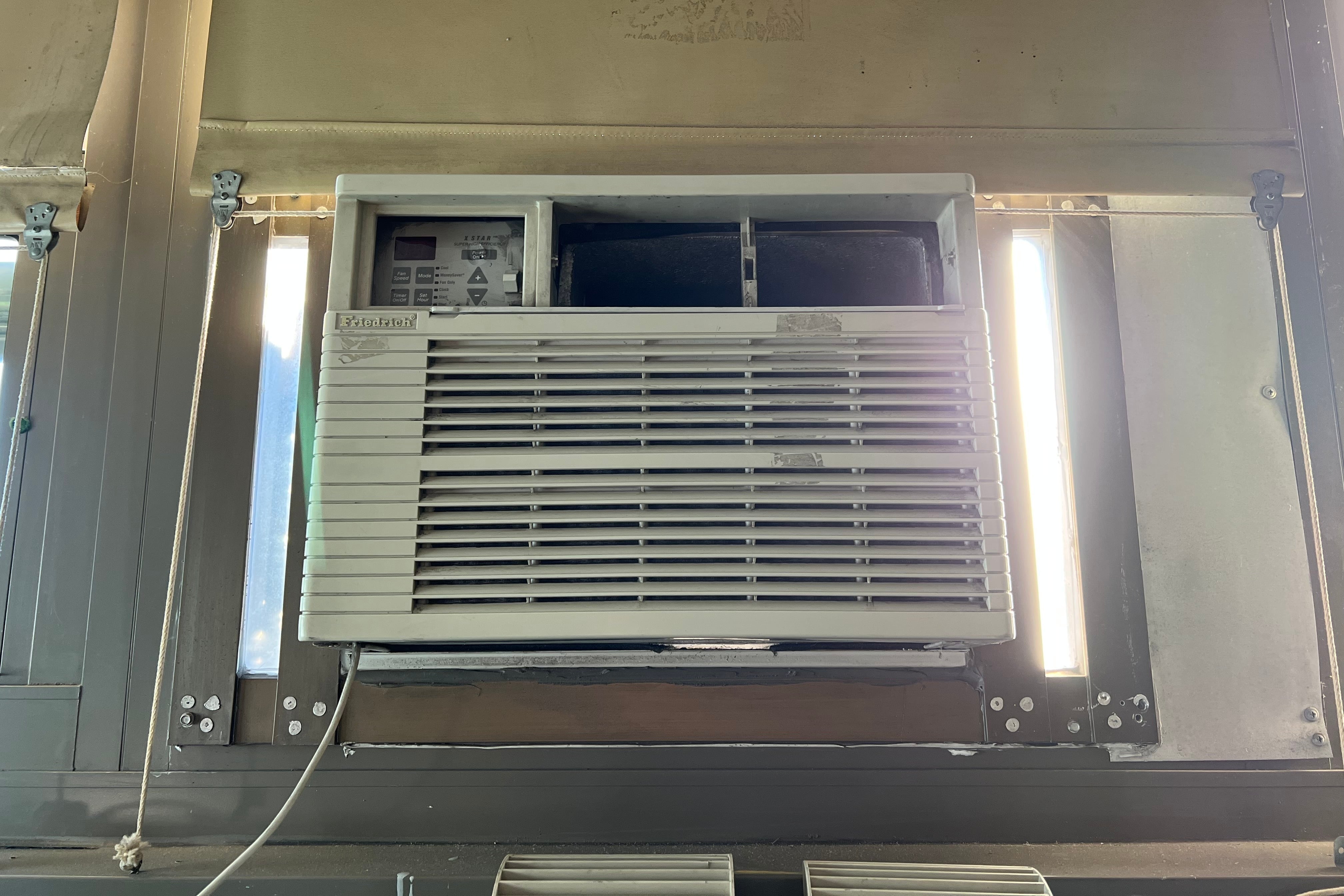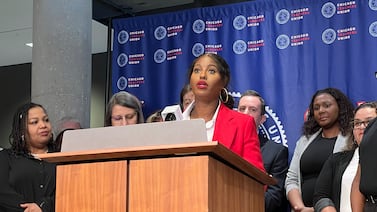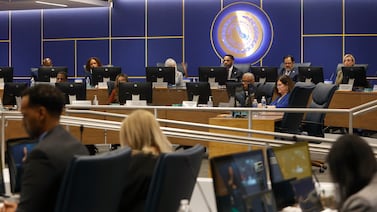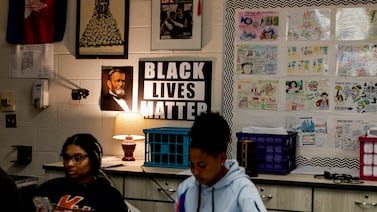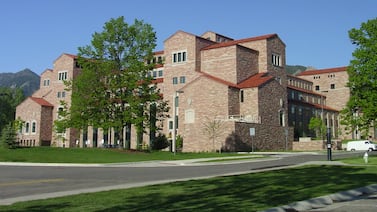Days before the school year started, New York City officials said they made good on a major promise: ensuring every public school classroom has air conditioning.
But as students and educators returned to their classrooms, some were still sweltering.
A Queens parent said her kindergarten son came home during the opening weeks of school flushed and sweaty. A Bronx student interrupted her teacher multiple times to complain about the heat. And a Brooklyn high school teacher fears his students will continue to cope by dragging their desks into the hallway to catch a whiff of cool air from other rooms with AC.
Five years ago, then-Mayor Bill de Blasio promised universal air conditioning by 2022. The city has made big strides, pouring more than $400 million into upgrading electrical systems and purchasing air conditioners for nearly 17,000 additional spaces — roughly 28% of classrooms citywide. It’s a significant accomplishment given aging infrastructure in many school buildings. And the upgrades bring some relief as climate change will likely spur longer and more frequent heat waves.
Yet dozens of educators, students, and parents told Chalkbeat there are still gaps in air conditioning coverage. In some cases, AC units were installed, but have fallen into disrepair and have not been fixed or replaced. In others, units have yet to be delivered, or school officials are waiting for upgrades to outdated electrical systems before switching them on. Some areas — including auditoriums and gyms — were never guaranteed air conditioning in the first place.
“I kind of laughed when they said everyone had an AC,” said Matthew Kennedy, a history teacher at Antonia Pantoja Preparatory Academy in the Bronx whose classroom does not have air conditioning. “It’s a premature pat on the back.”
In Kennedy’s classroom, students often complain about the heat the moment they walk in. On hot days, he forgoes direct instruction in favor of group work. “When you’re combating the heat the last thing the kids want is to hear you talk,” he said.
The situation is particularly challenging in the spring when he is working to prepare his students for Regents exams, which are typically required to graduate in New York. He often resorts to propping his windows open with textbooks so they don’t slam shut.
Kennedy said his room was slated for air conditioning, but the units that arrived were the wrong size, and new ones have yet to appear.
“The whole building has AC — it’s just like somehow we got lost in the shuffle,” he said.
Lost learning
Hot classrooms aren’t just uncomfortable — they can also adversely affect learning, researchers have found.
One New York City study showed that students who took Regents exams on 90-degree days were 11% more likely to fail an exam than on a 72-degree day. Heat can have detrimental effects beyond a single testing day: Students who took the PSAT in the fall performed worse if it was hot during the previous year and their school didn’t have AC, according to a national study.
“It’s not just one day, one test. It’s the accumulation of knowledge over the course of a year,” said Jonathan Smith, an economics professor at Georgia State University who co-authored the PSAT study. “Heat can certainly have an impact on people’s ability to learn.”
School years in New York City often include more than 30 days of temperatures of at least 80 degrees, according to a Chalkbeat analysis of federal data. Even temperatures below that threshold can have a negative effect on student learning.
Still, Smith said research on the relationship between heat and learning is limited, and not every study reaches the same conclusion. One study focused on Chicago Public Schools found that installing air conditioning, which cost $135 million, did not have a clear effect on test scores or grade retention. Smith noted that he’d like to see more research on whether air conditioning has other benefits, including reduced disciplinary infractions or improved attendance.
“It’s a worthy goal that’s probably a very hard decision for administrators to make because it’s so costly,” Smith said. “I think in the face of climate change, cities have to seriously consider ways to address the detrimental effects of heat and air conditioning is a clear solution.”
Broken AC on the rise
The latest figures show that New York City has made substantial progress installing air conditioning in recent years. Roughly 15% of classrooms lacked air conditioning according to data collected in 2020. This spring, that number fell to nearly 3%, and by fall, city officials claimed the project was “completed.”
Asked about specific classrooms that still lack AC units, city officials acknowledged some instances where AC is not yet available. A education department spokesperson also noted the city did not guarantee to add air conditioning where capital upgrades weren’t possible, in classrooms without windows, or in converted spaces that weren’t originally intended for instruction.
But even as air conditioning coverage has expanded, so has the share of units that are considered “non-functional.” Roughly 8% of classrooms have AC units that don’t work, according to data collected this year, up from about 6% in 2020. An education department spokesperson attributed the increase to the city’s installation of more air conditioning units overall.
The uptick in broken air conditioning units may pose challenges for individual school budgets because they are financially on the hook for maintaining and replacing AC units that don’t work once the warranty lapses, even if the city initially installed them at no cost to the school.
At P.S. 279 in Brooklyn, the now-defunct parent-teacher association helped pay for air conditioners years ago, but several of them have since stopped working, said Stacey McStine, an assistant principal.
Although the custodian was able to wrangle a freestanding unit for a prekindergarten classroom, other units “don’t turn on, don’t work, don’t cool the room at all, and they didn’t replace them” through the universal air conditioning program.
McStine worries the school won’t be able to get new units soon. “We’d really like a plan to replace units that are broken and don’t work anymore,” she said. “We don’t have money to fix it.”
Still, the school may soon get some relief. McStine said city officials recently promised to begin replacing the older units there.
‘I’ve seen some progress’
Maryam Choudhury, a senior at The Young Women’s Leadership School in the Bronx, said all of her classrooms have air conditioning units, but they don’t always work. Only one of the two units functions in the room where she has homeroom and AP environmental science, leaving it uncomfortably hot when temperatures rise.
“As a Muslim woman I like to dress modestly, so I don’t like taking off my sweater and showing my arms,” she said, noting that she also wears a hijab. “I am somebody who gets nauseous easily, so it was very hot and I couldn’t focus.”
Ramadan, which falls in the spring, is a particularly challenging time when temperatures rise because she refrains from eating or drinking during the day. “Some days I might not end up doing all the tasks I need to do within that class period,” she said, though Choudhury is typically able to make up the work.
Still, some educators said they’ve seen the benefits of new air conditioning. At Brooklyn’s Franklin Delano Roosevelt High School, officials have steadily added units starting on the top floors and working their way down, teacher Adam Schwartz said.
“I’ve seen some progress over the last three years,” he said. “When I see I’m in a room with air conditioning, I’m thinking about getting to know the kids in a comfortable space and finishing the year in comfort.”
But one of the three classrooms where Schwartz teaches does not have AC this year. He was told the units were ordered but have not arrived. (An education department spokesperson said the city is expediting work in the building.)
“The problem with the heat issue is that you’re so aware of your physical body — the discomfort, the tiredness, that it really pulls you back from losing yourself to intellectual pursuits,” he said.
Soaring costs
When the city first announced plans to outfit every school with air conditioning they indicated plans to spend nearly $29 million over five years to purchase and install the units with another $50 million in capital costs for electrical upgrades. The goal was to outfit 11,500 additional classrooms with air conditioning.
But the costs and scope of the project have ballooned. The city wound up adding AC to about 16,720 classrooms — at one point miscounting the number of rooms that needed it. The capital costs have grown to $380 million for electrical upgrades at 750 buildings, said Kevin Ortiz, a spokesperson for the School Construction Authority, or SCA.
Education department officials said they could not produce a full accounting of how much they spent purchasing and installing units. City records show the cost of purchasing and installing each unit is now $2,343, though officials said the number was lower in previous years without specifying an exact number. (Roughly 19,000 units have been purchased in total.) Including capital costs, the total outlay for air conditioning is likely well above $400 million — more than five times the education department’s initial estimate.
“Our Division of School Facilities is committed to creating safe and comfortable learning environments for our students,” education department spokesperson Jenna Lyle wrote in a statement. “We are proud of the work that has been done in partnership with the SCA to place air conditioners in all applicable NYC classrooms that previously lacked units.”
Still, even if the units were added, that doesn’t always mean classrooms actually have cool air.
Queens mom Yuliya Baer can see units poking out of the windows of the classrooms at P.S. 175 The Lynn Gross Discovery School. But even on hot days this September, there was no audible whirring because the electrical work has not been completed.
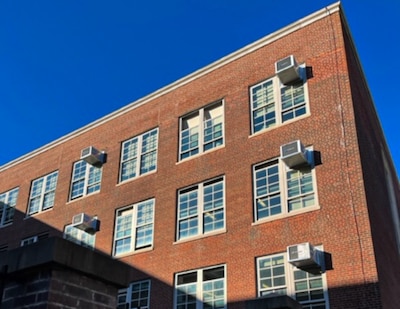
“Every day the kids complain, every day the teachers say, ‘Send extra water bottles,’” Baer said, noting she sent her kindergarten son with water bottles full of ice during the first week of school. “Parents see that there’s air conditioning in the window, but students come out hot and red in the face.”
To Baer, the notion that the city’s universal air conditioning program has crossed the finish line rings false.
“I went to that same elementary school — it was unairconditioned almost 20 years ago and it’s still unairconditioned,” she said.
That could soon change. Ortiz, the SCA spokesperson, said the electrical work could be completed as soon as next week.
Alex Zimmerman is a reporter for Chalkbeat New York, covering NYC public schools. Contact Alex at azimmerman@chalkbeat.org.

